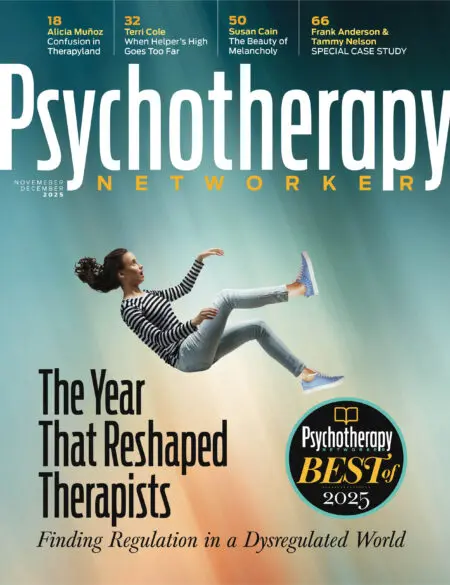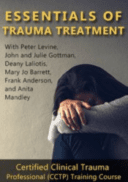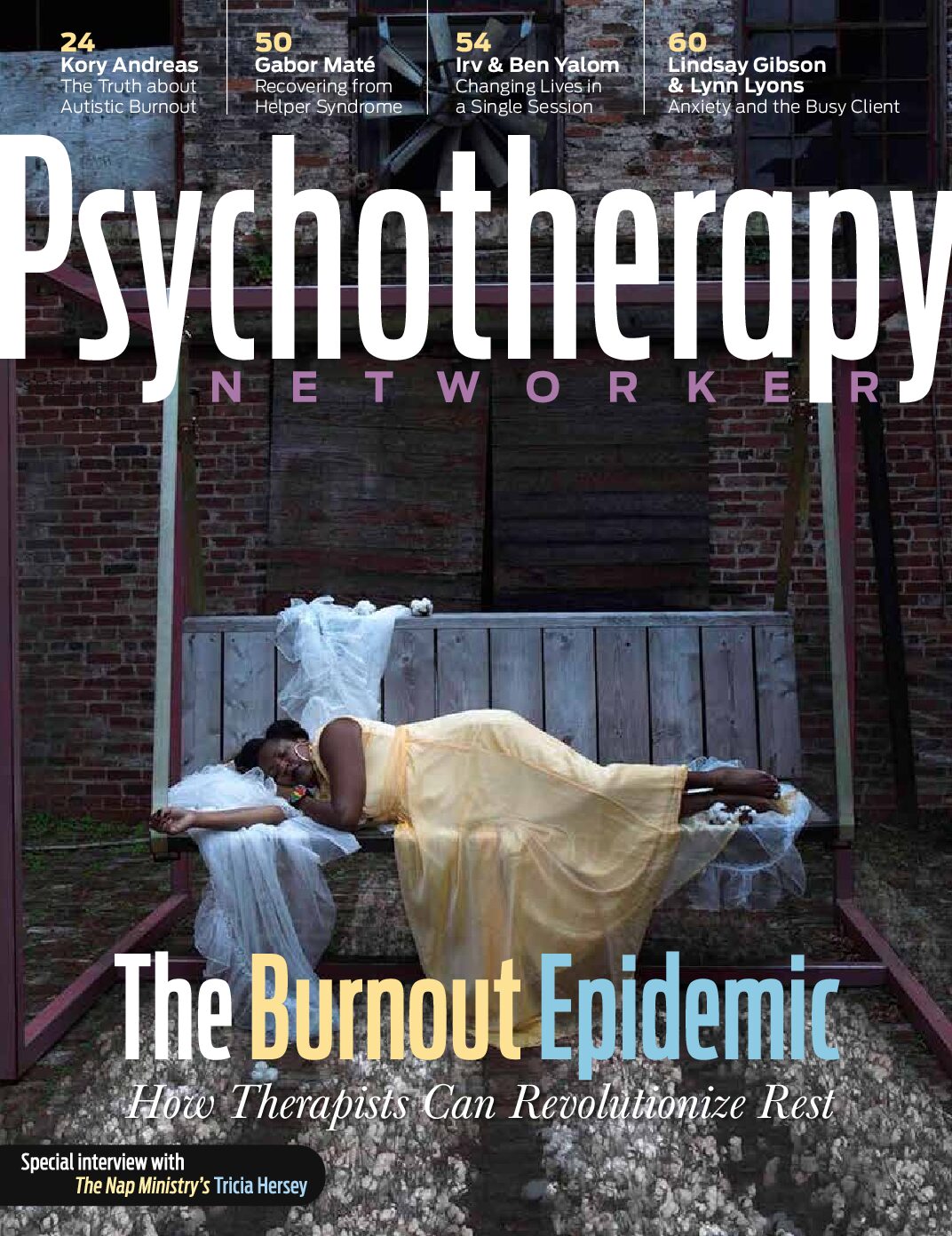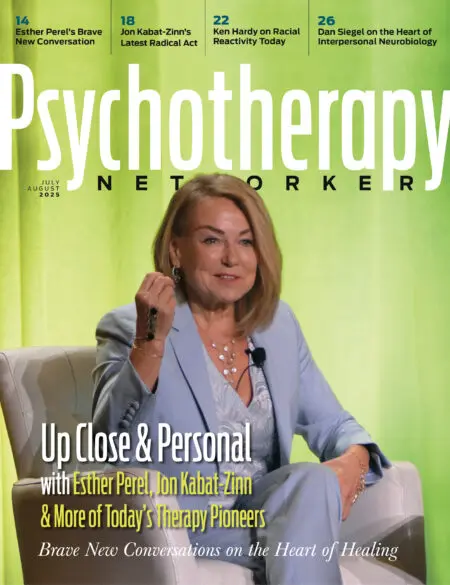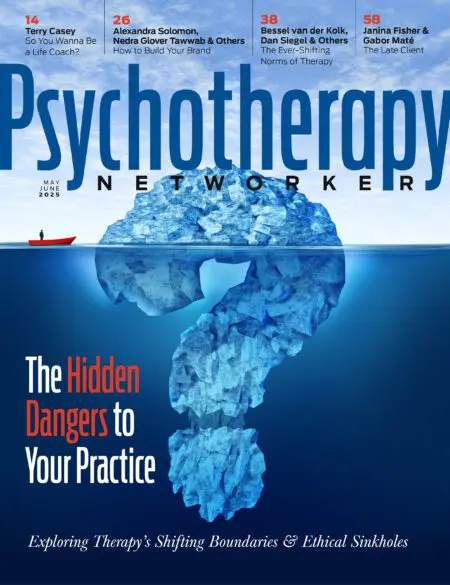Enjoy the audio version of this article—perfect for listening on the go.
“Kory, you might be the first human face I’ve seen this week, but I absolutely can’t turn the camera on today,” my client Sarah tells me as soon as our session starts. “I haven’t showered in days, and my hygiene ick factor has crossed a threshold that demands isolation, even virtually.”
“Sarah,” I say, “we give the ick factor what it wants on days like this. Camera off it is.”
Sarah is a 33-year-old data scientist, who just bought her first home in a trendy suburb near Washington, DC. She and I have been working together for two years since she sought out an autism assessment at the end of the pandemic.
Like many Autistic people, she found her mental and physical health to be uncharacteristically improved after months of lockdown. The absence of forced socialization, rigid work schedules, and grueling travel had put her mind and body at ease. But now that her job was requiring all employees to go back to the office, she reports her health is rapidly declining, and she’s no longer sure she can power through. For months, our work has been focused on autistic-burnout interventions.
Autistic burnout is a predictable and debilitating reality for many late-diagnosed Autistic adults. Usually, it’s marked by depleted energy, an inability to work or maintain a schedule, and a significant reduction in resiliency and coping skills. On the surface, it may present similarly to depression in neurotypical clients, but treatment is considerably different. In fact, my neurodivergent clients generally experience minimal to no relief from depression medication, well-meaning therapeutic suggestions for self-care, or other mainstream clinical recommendations.
Autistic burnout forces many Autistic adults to drastically change the scope of their work-life balance. They may need to stop working altogether or reduce their hours in order to get their body back to homeostasis. But when Sarah tried to request “reasonable accommodations” through her HR department, they told her that unfortunately the nature of her job precludes her from telework and flexible scheduling. She’s missed 23 workdays in the past two months and is currently having daily migraines, GI problems, and chronic joint pain due to fibromyalgia. Construction just finished on her new home, and she has no partner to help with expenses.
She can no longer afford weekly therapy sessions but has agreed to meet for an emergency session on a sliding-fee scale to come up with a plan.
Sarah is always on time for our sessions. “I appreciate you making time for me,” she says. “I’m sorry I’m such a mess. Mr. Catatonic and I haven’t been able to move from our couch-to-bed circuit since I got home from work Friday. I’m so fucking lazy right now, I don’t know what the hell is wrong with me.”
“Coming in hot today with the self-compassion! The self-blame monster has arrived at the 90-second mark of therapy,” I joke.
I hear Sarah giggle. It’s not uncommon for us to find some humor in her self-deprecation. “I knew I was in trouble as soon as I said the word lazy,” she says. “You weren’t going to let me get away with that.”
“That’s right, you’re in big trouble. Did you hear that, Mr. Catatonic?” I’m speaking to her cat now, who has the best name I’ve ever heard. “Your mom needs rest, and she’s being mean to herself. Please remind her that slowing down and listening to her body isn’t laziness. She needs a review of your rest-and-relaxation protocols.”
“Mr. Catatonic never met a nap he didn’t like,” she agrees.
“He exists solely as a role model for self-care and emotional regulation. Kind of him to donate his body as a living spirit animal for you,” I say.
“He doesn’t have to pay $6,000 a month for this stupid house that I was so sure I wanted to build. And he doesn’t have to work 40 hours a week. And he doesn’t have crushing anxiety, joint pain, rashes, migraines, Ehler Danlos, or PMDD.”
“Do you think Mr. Catatonic is lazy?”
“He is, but it’s cute when he’s lazy.”
“And when you slow down?”
“It’s not cute. It’s terrifying.” I hear her take a breath. “Honestly, I just don’t know how much longer I can exist like this. I can barely get out of bed.”
“Burnout is no joke. Want to dive into the feels today, or make a plan? Or both?” I ask.
“Let’s start with a plan. I don’t want to lose my job.”
A Frozen, Grieving Body
Sarah isn’t alone in her struggle with autistic burnout. At least 50 percent of my caseload of late-diagnosed Autistic adults have sought neurodivergent-affirming therapy to address issues similar to Sarah’s. Few, if any, of my clients have made it to adulthood without finding themselves trapped in the burnout cycle. Autistic burnout has been largely responsible for their school refusal, failed relationships, missed worktime, and withdrawal from the special interests that once brought them joy and occupied large portions of their time. An Autistic adult who can’t access their special interest will undoubtedly spiral into a mental health crisis. Special interests, solitude, time with nature, and uninterrupted flow-state time are critical for autistic health and wellness.
Without the cognitive, emotional, or physical bandwidth to pursue the activities that are dear to them, Autistic people also don’t have the bandwidth to stay socially engaged.
Many Autistic adults have been conditioned to mask in the face of these struggles, but given that masking is exhausting—and likely contributed to their burnout—well-meaning therapist suggestions like “get out and spend time with friends” or “journal your feelings” will quickly fall flat. What many therapists may not realize is that autistic burnout is characterized by a tremendously powerful decline in functioning, resiliency, and energy that makes task initiation virtually impossible. Autistic bodies are significantly more sensitive than neurotypical ones. While many depressed neurotypicals can continue to work while struggling, Autistic individuals in burnout often find themselves unable to show up in any area of their life.
I’ve watched burnout take hold of an Autistic Ivy League freshman, forcing them to return home within months of their transition to the prestigious school they were thrilled to get into. I’ve seen burnout touch down with the force of a tornado on Autistic doctors, physicists, leaders of government agencies, therapists, self-employed creators, and tech experts. No matter how old they are or how they spend their days, none of the people I work with are immune to the debilitating regression of skills, energy loss, or grief that accompanies autistic burnout.
We therapists certainly didn’t learn about autistic burnout in school. When a client reports symptoms of apathy, lack of energy, inability to do things they once did easily, and an increase in sleep, most providers believe the client is suffering from depression—and they treat it as “neurotypical” depression, both in therapy and with medication. When the client’s struggles remain unchanged, they’re baffled.
What we don’t always understand is that Autistic clients require unique interventions to treat their burnout, which is as much a physical problem as a mental health struggle. This is the paradox of autistic burnout. While the Autistic brain yearns for connection, stimulation, and purpose, the body has slammed on the brakes in a way that can’t be changed with behavior modification, motivation, or a positive mindset because the problem is biological. Doing the very things that would soothe the pain of loneliness, like calling a friend, land on the body like a threat to their survival. Chronic fatigue, skill regression, debilitating sensory overload, autoimmune flares, and worsening executive functioning often sabotage even the best attempts at self-care. It’s not that burned out Autistic adults don’t want to do things differently, it’s that they can’t—and traditional therapeutic interventions assume internal access that simply isn’t there. Autistic burnout is the quiet and often invisible devastation of a brain that’s hungry for life but tethered to a body that’s frozen.
Sarah’s love of learning, her friendships, her work ethic, and her problem-solving abilities have all been casualties of her burnout. Because I’ve seen many clients through to the other side of burnout, I know these strengths can return to her, but the tough reality is that it’s likely to take a long time. No pill, self-care practice, or tool can quickly restore Sarah’s previous lifestyle. However, I trust in the slow process, and continue to let Sarah know that I’m here with her and I’m hopeful.
In my neuro-affirming practice, Sarah knows I know how hard it is to live with a body that shows up inconsistently and a brain that gives all or nothing. Today, we make a plan to get her house cleaned up with a friend, to push the send button on a grocery delivery order, and to send an email (which I help her write) to her doctor requesting an adjustment to her ADHD and anxiety meds. These practical strategies, paired with some honest exploration of grief, and a side of permission to ignore texts from less-than-helpful family members results in a less teary, more resourced Sarah. Hope alone won’t pull her out of burnout, but it may get her to the next step of our plan.
We’ll work toward improving the predictability of her life to help her nervous system feel safer by creating more structure and consistency in her daily routines. A calmer nervous system is more available for a gentle reintroduction of the things that once lit her up: her crafty special interests, solo hikes in the woods, low-demand online connection with gaming friends, and expanding her sense of community in places where she doesn’t have to mask. This slow scaffolding helps her brain, body, and nervous system get acclimated to incremental changes so that when her energy returns, she can reenter other spaces for other activities.
Parenting Without a Village
My 8:00 p.m. clients have been working with me for three years. Their nine-year-old- daughter, Ava, has been in chronic burnout for 18 months. She’s been in two private schools, both of which claimed she “isn’t a good fit.”
Her parents, Autistic themselves, hoped that the local public school could help her work toward attending more regularly. But while the school claims Ava has trouble with “school refusal,” we know the issue is her incredibly sensitive nervous system. It makes everyday expectations—such as transitioning to the school setting from the school bus, sitting in a chaotic classroom, and socializing on the playground—almost impossible for Ava. When she’s deep in burnout, she also becomes paranoid, and thinks other students are talking about her. She’ll throw objects if triggered and has engaged in unsafe behaviors at school, like stabbing herself with a pencil.
After a meltdown, Ava is inconsolable and filled with shame. But until she comes out of burnout, she’s unable to handle unpredictability, which includes new social situations or anything related to schooling. Her mom has quit her job to be home with her and does late-night consulting work to make ends meet.
Although Ava sees a psychiatrist for medication, she’s often unable to take it and spends her days in survival mode, kicking, hitting, and threatening her mom, who is often on the receiving end of these behaviors. Ava’s burnout also includes sleep issues (she wakes up several times a night in terror), shutdown behaviors (she sometimes can’t move off the couch because she says her legs don’t work), destructive behaviors (just last week she threw a glass at mom’s head and broke her own iPad), running away (not just down the street but into the street), and urinating on herself. She may go weeks at a time without bathing because she can’t handle the transition into the bathtub, and can only tolerate eating three foods: chicken nuggets, French toast, and mac and cheese.
Ava is formally diagnosed as Autistic, but her family is working with me because they suspect she has a PDA profile. Pathological Demand Avoidance, or Pervasive Drive for Autonomy, is widely considered a subset of Autism. It’s becoming more commonly understood as a significant and debilitating combination of Autistic traits and extreme nervous system reactions that cause the body to respond dramatically to daily stressors as if they’re life-and-death situations. PDAers have incredibly sensitive neuroception and experience everyday demands and expectations—such as requests to brush their teeth or answer direct questions—as dangerous threats to their autonomy that can send them into a fight/flight/freeze response, especially when they’re in burnout.
But Ava is still a 9-year-old girl. She loves reading, gaming, bracelet making, Roblox, and dinosaurs. She wants nothing more than to connect with other kids her age. Unfortunately, most of her former friends’ parents have made it clear that they don’t want their kids engaging with Ava because her behaviors can be so dangerous and unpredictable. This double-edged sword of yearning for connection and being harmful toward the people she loves is a terrifying rollercoaster Ava can’t seem to get off of.
Her parents are also burned out. They’re running out of resources and are entirely socially isolated. Beyond the world of internet chat support groups, no one in their lives understands their daughter’s struggle, or theirs. Because Ava’s behaviors are a physical trauma response, no amount of talk therapy or revisiting triggers and behaviors can help her make different choices. Teachers, helpers, and medical professionals are quick to observe Ava’s behaviors and blame my clients as her parents, or assume she’s coping with trauma. Trauma is a great guess, but the call is “coming from inside the house.” Ava’s sensitive nervous system means that when she’s in burnout, almost everything lands on her body as trauma.
As a PDA-informed therapist, I know the best way I can support Ava is to support her parents. So I work with them to shift their mindset from a neurotypical parenting approach to a low-demand approach better suited to accommodate Ava’s nervous system. We strategize, grieve, seek out additional resources together, and use IFS techniques to explore the parts of them that need attention as they focus their resources on their daughter’s safety. Ava’s parents also each work with their own neuro-affirming therapists to keep tabs on their own burnout.
In four weeks, Ava gets an emotional support animal. Her love for animals seems to be the only tool that helps her calm her body with any regularity. While medication is typically a necessary part of getting out of burnout for PDA kids, Ava struggles with pills, patches, and especially injections. We’re hopeful that their new golden doodle named Roxy (short for Hydroxyzine) will have a calming effect and help give her body some necessary peace. For many Autistic individuals, support animals provide a type of coregulation that other humans can’t. They’re a powerful example of how nontraditional interventions can meet specific Autistic needs in ways that actually work.
Treating Autistic Burnout
Autistic burnout is complicated to treat without knowledge of how autistic brains and bodies work. Although it often presents like depression, the main driver of autistic burnout is anxiety. In burnout, life becomes one giant mountain of task-initiation anxiety, which makes doing anything impossible. While depression is marked by intense sadness, most Autistic adults in burnout don’t report “sadness” unless the burnout itself has gone on so long that depression has become an additional concern. Instead, after spending all their energy on masking as neurotypical in a world that doesn’t accommodate them, they report having no reserves to draw from.
Fortunately, with the right blend of supports, Autistic people can get to the other side of burnout, like my client Dave did. He’s a 35-year-old director of a nonprofit and last year, he couldn’t force himself to meet expectations at work or home. Deadlines were missed, bills were piling up, and he was spending more and more time drinking, sleeping, and scrolling. Then Dave made a bold choice that not all of us have the resources to make. He quit his job and began teaching CrossFit like he had in his 20s. He returned to woodworking and read a book a week. He swapped scrolling for listening to podcasts. And he swapped drinking for daily anxiety meds, which included a beta blocker for additional support in overwhelming situations. He also spent an hour in nature each day and recommitted himself to autism-affirming therapy to help with his relationships and keep a handle on his routines.
Within six months, Dave was ready to get back to the working world. The new job he took had a flexible telework policy that allowed him to accommodate himself at home up to four days a week. He still spends time outside each day, saves energy for special interests each week, and has continued to reap the benefits of anxiety medication. For neurodivergent clients, special interests are not merely hobbies. They are needs.
A year ago, Dave would’ve told you he wasn’t anxious. He would’ve said he was just tired and hated his job and his friends. Without the training to know what Dave wasn’t saying, most therapists might’ve concluded that he was in a depressive episode. The interventions that worked for him should be at the center of all autistic-affirming care: neurodivergent-informed medical supports, workplace accommodations, appropriate rest, a return to basics including routine, special-interest time, supportive social relationships (online or in person), consistent time in nature, and low demands to restore the body’s felt-sense of equilibrium.
Our job as providers isn’t to drag clients out of autistic burnout—it’s to help them understand themselves better so that they can be the expert on whatever comes next. As a fellow Autistic person, I’ve learned to sit in the room with tremendous compassion for my clients in burnout. I too have had to make monumental changes in my life, my career, my self-care, and my surroundings to avoid burnout-related spirals. I mean it when I say our productivity does not equal our worth, and I understand the constraints our capitalistic society puts on Autistic adults who have to be constantly aware of their capacity to perform.
Sarah isn’t lazy. Ava’s parents aren’t permissive or soft. Dave wasn’t depressed. These clients were in burnout in a way that only Autistic people with their highly sensitive nervous systems experience. Until our world makes room for them, and for the way their brains and bodies work, autistic burnout will continue to disrupt the lives of our neurodivergent clients, diagnosed or not. Our job isn’t to pathologize their burnout, and we have to be careful not to further the invalidation they already experience. It’s to understand it and help our clients make necessary changes in their lives. It’s also to advocate like hell for them so they don’t continue to mask their way into collapse.
Today, at my own first signs of burnout, I’m quick to echo the wisdom of Mr. Catatonic: I take a nap. But I’d be lying if I said that was a reliable fix for anything. My mental and physical homeostasis rely on a blend of supports, from work accommodations to wardrobe choices, medications to unique self-care routines, special interests to solitude. I can’t maintain any of those interventions in a vacuum. And neither can my clients.
In the end, no amount of “self-care” vacations, talk therapy, or journaling will help an unaccommodated Autistic person emerge from burnout in a neurotypical world. Burnout requires significant support from providers informed about the extremes of the autistic experience.
Kory Andreas
Kory Andreas, LCSW-C, is a clinical social worker and Autism specialist devoted to supporting neurodivergent individuals through assessments, therapy, and education. A late-diagnosed Autistic adult, she consults with government organizations, mental health treatment facilities, and therapy practices to equip them with strategies for fostering truly inclusive and neurodivergent-affirming environments. You can connect with Kory on Instagram @neurokoryous or through koryandreas.com.
